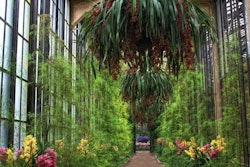 Photo: Jill Odom/Total Landscape Care
Photo: Jill Odom/Total Landscape CareTopiaries may not be the most commonplace items in a landscape, but when they are present, they can be quite a sight.
Topiaries can come in a multitude of shapes and sizes, and they are found all across the nation. Whether or not you’ve had a customer so far ask for one of these attractions in their yard, it’s always a good idea to know how to style these jolly green giants just in case.
Not only does knowing this technique make you more marketable as a whole, but it also gives you and your company a unique set of skills that can set you apart from the competition.
Learning how to create and maintain topiaries can help you know exactly what you’re getting into before talking with an interested client.
Choose what will make the shape
The starting point of a topiary can either be formed by using one plant or a compilation of many smaller plants, and there are two types of topiaries: new and old world.
 Photo: Jill Odom/Total Landscape Care
Photo: Jill Odom/Total Landscape CareFirst, begin the process by determining the makeup of the topiary to find out its needs and how best to take care of it.
Old world topiaries, which are shrubs planted in the ground, do well along with plants that thrive on regular shearing. A few examples of old world topiary plants are Eugenia, podocarpus, yew and boxwood.
New world topiaries are defined by plugs that are planted into sphagnum moss. They are adaptable plants that thrive in shade and sun, and they can adapt well to frequent grooming. They also have a dense and compact growth habit. A few examples of new world topiary plants are ajuga, bronco sedge, creeping fig, alternanthera and stonecrop.
Using water and supplements
Regular watering, whether dealing with a large or small topiary, is a must. Just like other plants in the landscape, topiaries require just as much care and attention.
Some topiaries can have internal irrigation systems installed like drip, but they can’t always be counted on to meet the individual needs of the plants. Some additional steps may be required depending on the type of topiary your customer would like.
These systems can be supplemented by traditional hand watering. Put the water where it’s needed, and check smaller, more narrow places that may dry out quicker. Avoid watering the larger areas and the under belly, as they tend to hold water longer and stay moist.
Be sure to soak the plant well before applying fertilizer to avoid burning the foliage. Adding in bionutritional products can also help give plants an organic and nutritional boost.
Keep the shape defined
Obviously, the main appeal of a topiary is its shape. Since the plants don’t come in these shapes naturally, it’s up to you to help it maintain its crisp, fresh and gorgeous look.
To maintain the shape, you can use scissors, extended shears, hedge clippers, electric hand shears or Japanese topiary pruning shears. Always make sure tools are clean and sharp, as this will help ensure you get a clean cut.
Live inspiration
Along with being a unique skillset in the design department, topiaries also offer a unique item for sightseeing.
Those who love plants and gardens will naturally be drawn to topiaries, but even those uninterested in the green industry will stop, take notice of and potentially find more interest in plants shaped like other objects or animals. Topiaries can be used in residential or commercial properties, so don’t feel limited when assessing a customer’s landscape potential.
 Photo: Jill Odom/Total Landscape Care
Photo: Jill Odom/Total Landscape Care









